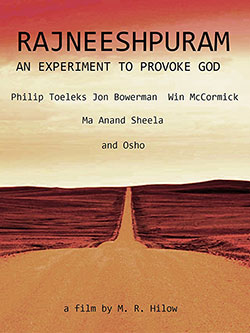Rajneeshpuram, An Experiment to Provoke God

Viramo’s review on this “even-handed, skillfully produced movie originally made for public television.” Written, directed, produced and co-edited by Deva Michael, it was first shown on KCTS (Seattle) in 1993. Now available as DVD or via streaming.
Can we celebrate now …?
Let’s all take a deep breath and celebrate the final whimpers of the toxic potboiler ‘Wild Wild Country‘ that took the world by storm. The six-part documentary launched on Netflix in mid-March of 2018 and exposed millions of people to “The Bhagwan” and his sex-crazed followers. It was a tabloid saga of sex, guns, and violence – red meat for the masses.
And it was about us, Osho’s people, and the miracle we created in the middle of nowhere, a desert wasteland in central Oregon USA. Cowboy country. Rednecks ’R Us. The docu should have been called “The Sheela Show,” as the haggard, haunted-looking former secretary to our Master was chosen to narrate the series. A dubious choice. Many of us watched in shock and awe as the series unfolded. Presented as a crime drama, WWC was a horror movie for many of us. One friend said his nervous system suffered serious disruption just from watching the trailer.
Netflix is available in 190 countries. The popular network doesn’t reveal viewership numbers, but WWC was on its “trending” list for months. Untold millions have now been exposed to Osho energy. Those with eyes to see, including many young people born long after Rajneeshpuram closed down, will get it, their curiosity aroused by the Osho phenomenon. First-time visits to the website Osho.com have reportedly seen huge increases since the documentary aired.
So be it. Now, out of the shadows and the mists of time comes ‘Rajneeshpuram, An Experiment to Provoke God’. This one-hour documentary is neither an antidote to WWC nor a response to the lurid sensationalism of the Netflix series. Nor is it a PR puff piece produced by the ashram for sannyasins and their friends and relatives, or for newcomers to Osho’s world. None of the above.
‘Rajneeshpuram’ is an even-handed, skillfully produced movie originally made for public television in Washington State. It was written, directed, produced and co-edited by a sannyasin, with the full cooperation of Osho International Foundation and input from several sannyasins. It first showed on station KCTS, a Public Broadcasting affiliate in Seattle. The year was 1993.
Deva Michael wanted a ‘broader audience’
Filmmaker Deva Michael was a Ranch resident from 1981 to 1985, working (sorry, worshipping) as a handyman, plumber, HVAC specialist, and fireman, the latter job at both Rajneeshpuram and Antelope. “When the ranch folded,” he says, “I ended up back in Seattle and started a new life as an actor, stuntman and filmmaker. Around 1990 I released my first documentary, ‘Temporary Dwellings’, a study on poverty, homelessness, and the enduring human sprit. That film went on to receive some critical attention, and building on that I decided to tackle a full-length piece on the ranch.”
After ‘Rajneeshpuram’ aired on KCTS, followed by a flurry of film festival screenings, Michael turned it over to a distributor. New audiences were found: several hundred US universities acquired the film for their sociologic and religious studies programs, and many European countries broadcast the film in the mid- to late 90’s. Meanwhile, no other TV outlet in the US would broadcast it.
Full stop. For nearly twenty-five years, ‘Rajneeshpuram’ existed in a film vault somewhere, unseen by the public but not forgotten by its creator. When WWC exploded all over the world, Deva Michael says it inspired him “to get a broader audience for my film.” Indeed. Michael’s film is now available worldwide on Amazon TV (also known as Amazon Prime Video), a powerhouse in the streaming business whose reach is equal to or greater than Netflix’s.
The movie is a real jewel, a must-see for anyone who is not deeply asleep. It is historical in scope, framing a chapter of profound spiritual evolution with Osho at its core. The title comes from Osho’s famous quote from Sufis: The People of the Path, vol. 2: “And this whole experiment is to bring a kind of Buddhahood into the world. This commune is not an ordinary commun This is an experiment to provoke God.”
The format of the movie is almost munane in its presentation: it plays as if it is modeled on the popular PBS documentary series ‘Frontline’. The narrator, Ken Wiley, is straight ahead and unemotional. The real emotion, the underlying drama, comes from the events themselves, the slowly gathering storm, the interviews with the sannyasins who lived it, the redneck cowboys who opposed it, and the government officials who wanted nothing more than to destroy the Ranch and Osho himself.
Prem Niren, Osho’s chief lawyer, was born and grew up in Oregon and sets the stage early on: “Oregon is divided into two major parts, east and west of the mountains. East of the mountains is redneck country, cowboy country.” Thus setting the stage for a culture clash of monumental proportions. Rancho Rajneesh was born in a hornet’s nest of bigotry, religious extremism and fear of “the Other.” Someone didn’t do her due diligence. Or perhaps, as Osho says in that famous quote [in the above mentioned discourse series], “You may not be aware of what is going to happen. You may be aware of only your problems. You may have come to me only to solve your problems. That is secondary. I am cooking something else.”
Osho arrives in America
The film’s first five or so minutes are devoted to Osho’s boyhood and his enlightenment, his career as a university professor and public speaker, the Pune One chapter, and his departure for the USA in 1981. There is some rare footage in the early days segment, some rare photos of “Raja” and family, and heretofore untold anecdotes about the young mystic. (As a boy, he enjoyed telling detective stories and reciting poetry!)
Osho’s arrival in New Jersey and his recovery at the Chidvilas Meditation Center there are well-documented. Soon enough, Osho and his party are off to Rancho Rajneesh in the middle of Eastern Oregon. Before the movie dives into the Ranch segment, a history of the Big Muddy property is shown, plus a history of Antelope, a once-thriving and important cog in the development of the American West. There’s some great footage of the earliest days of the Ranch. Deva Michael was there, his skills as a handyman badly needed.
Without giving away too much of the movie’s content, suffice it to say it follows a now-familiar trajectory: From the fight to incorporate the city of Rajneeshpuram to the hotel bombing to the Share-a-Home program to immigration to Sheela’s departure to Osho’s arrest and … and …. The two major pieces of the Rajneeshpuram story omitted by WWC and the media – who is this man Bhagwan? and the environmental miracle that was created out of nothing – are well covered by Deva Michael’s film. There is wonderful footage of Osho throughout all stages of his life. The hard work by sannyasins to create Rancho Rajneesh, and the off-duty playtime, such as the disco and the casino, are well documented.
‘Rajneeshpuram’ goes to great lengths to be fair and balanced, presenting both sides of every conflict and legal issue. Sometimes the spokespeople for each side appear as if in a debate, thanks to skillful editing. Also, the interviews in Deva Michael’s movie are priceless. Early on, in an interview with Win McCormick, the Oregon journalist who wrote a poisonous 12-piece hatchet job on the Ranch and the sannyas movement, said of Osho and the Ranch: “He did it to get attention. He did it to get himself in the news and in people’s consciousness.” Well, he certainly got everyone’s attention, sitting in his room in the Lao Tzu compound in silence and not speaking publicly for more than three years.
The main mouthpiece for the Antelope contingent is Jon Bowerman, who was also the principal hate-monger in WWC. This former horse trainer and rodeo cowboy, now 80 years old, is the son of Bill Bowerman, co-founder of Nike and a multi-millionaire. During the contentious legal wrangling of the Ranch years, the senior Bowerman was the chief financier of 1000 Friends of Oregon, a purported land use group that tried to destroy the city of Rajneeshpuram in court. (This data on the senior Bowerman is not in Michael’s movie.)
The junior Bowerman, who often complained in interviews that the “Rajneeshees” were lousy neighbors, once infamously said, “It wasn’t that they were asking to be shot, they were positively begging for it. We took the gun racks out of our pickup trucks because we didn’t want to be tempted….”
Said Sangeet Henry: “Most of the people on the Ranch for a long time had no idea of the antagonism or the things we in the Peace Force had to deal with. So they were able to have their joyous free life in a safe environment without having to deal with violent people or cowboys with guns, drinking and shooting… That was my position, and it felt sacred to me.”
‘Rajneeshpuram, An Experiment to Provoke God’ is a beautiful and memorable transmission of how Osho’s “red people” provoked not only the Christian God, but also provoked the people of Antelope and Wasco County and the farmers and ranchers and cattlemen of the area as well as government officials and politicians from Oregon to Washington, D.C. The film itself is a gift from Deva Michael, a heartful and truthful rendering of a chapter in history that many of us experienced firsthand – and helps set the record straight for us and everyone else.
But for some sannyasins the question still lingers: What was that all about? What just happened? Niren has an answer: “This was a game for us to wake up … and to have a good time! To live as creatively and alive as we could.” And we did, we truly did.
Details
Archival footage for the film, as well as music from the World of Osho, was licensed to Deva Michael by Osho International Foundation.
‘Rajneeshpuram, An Experiment to Provoke God’ is available in most countries for streaming on Amazon TV, also known as Amazon Prime Video. You can also buy or rent a DVD of Deva Michael’s movie at Amazon. Available also from www.oshoviha.org.
Related article
Wild Wild Journeys of the Heart – The making of the documentary ‘Rajneeshpuram, an Experiment to Provoke God’, the events that led to it and that followed. Viramo interviewed the filmmaker, actor and stunt coordinator Deva Michael
Review by Viramo
More reviews and articles from this author on Osho News
- Log in to post comments
- 72 views
